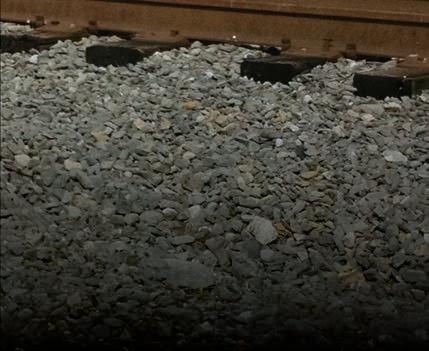
5 minute read
FRA RT&D
by Railway Age
TECH EVOLUTION VEHICLE



Consistent with the U.S. Department of Transportation (DOT), the primary strategic goal of the Federal Railroad Administration (FRA) is safety. The FRA mission statement reflects this priority: promoting the safe, reliable, and efficient movement of people and goods by rail. Safety has been and remains the principle driver of FRA research and development, carried out by the Office of Research, Development and Technology (RD&T).
RD&T safety improvements date back to the earliest days of the DOT. Highway-rail grade crossing fatalities have decreased by more than 66%, and track-related accidents have decreased by 21% since the 1970s. From 2009-2018, signal-related accidents decreased by 19%. And safety improvements have in turn furthered other DOT strategic goals: state of good repair, economic competitiveness and workforce development. Continued congressional funding for RD&T has made these safety accomplishments possible.
FRA collaborative research with federal, state and local public partners, academia and private industry supports the Department’s strategic safety objectives. Playing an integral role in advancing rail safety research are FRA’s test facilities— the Transportation Technology Center (TTC) in Pueblo, Colo., as well as the Volpe National Transportation Systems Center (Volpe Center) in Cambridge, Mass. TTC consists of facilities, equipment and nearly 50 miles of railroad test track, including a Positive Train Control (PTC) test bed and a tank car impact wall. The Volpe Center is home to the Cab Technology Integration Laboratory (CTIL), a high-fidelity, fullsized locomotive simulator configured with state-of-the-art tools for studying An overview of the Federal Railroad Administration Office of Research, Development and Technology. BY DR. MARYAM ALLAHYAR WYRICK, FEDERAL RAILROAD ADMINISTRATION

the boundaries of operator capability and performance and the impact of new technologies on operators.
FRA research and development programs correspond to different aspects of the railroad operation systems: human factors, track, rolling stock, equipment, signal and train control communication, and hazardous materials. Research projects are prioritized based on FRA safety performance data and risk analyses. A safety risk model ranks individual hazards and provides an indication of where RD&T project investments may have the greatest safety impact. Note that many topics, such as trespassing, grade crossing safety and derailment, can fall into multiple technical disciplines.
After prioritizing safety risks, RD&T undertakes two main types of research projects: theoretical and applied research. The first type acts as a catalyst to introduce new technology. FRA assumes the initial risk and, in some cases, the cost of proving a concept. Prototype development and demonstration is accomplished in collaboration with industry partners. RD&T research results are then shared in published reports and at various forums, which leads to the adoption of patents for new technology by private industry.
One such technology is the Autonomous Track Geometry Measurement System (ATGMS), which can inspect track conditions using unattended instruments mounted to revenue trains. Today there are dozens of ATGMS systems in service in the U.S., with more in production for future delivery. Another technology is a system for detecting sediment erosion, or scour, around bridge foundations in river beds. More than 1,000 scour sensors have now been installed on railroad bridges across the country.
The second type of FRA research involves cases where industry seeks to adopt new technology. RD&T provides the scientific foundation for the necessary regulatory compliance waivers or to safely test, demonstrate and ultimately implement the technology on a widespread basis. A recent example is the use of liquefied natural gas (LNG) as an alternative locomotive fuel. RD&T continues to conduct research and assess safety risks associated with using LNG to establish a basis for FRA standards for safe operation.
Other recent technological innovations to improve safety in train operations and the efficiency of track inspections include automated systems for train control such as PTC, autonomous inspection of railroad assets using unmanned aerial vehicles (UAVs), and artificial intelligence (AI) to process data. The use of UAVs, coupled with AI, has the potential to greatly improve track inspection efficiency and accuracy.
New technology can also mean innovative approaches to safety culture and new operating practices, such as FRA’s successful Confidential Close Call Reporting System (C3RS). Additionally, FRA workshops on trespassing, grade crossing safety and suicide prevention enable industry stakeholders to discuss priorities, concerns and best practices. Advances in computer simulation give FRA new ways to assess safety without requiring rail vehicle testing during operational service. This approach has been achieved through regulatory streamlining, and yields a reduction in the time and cost required for rail vehicle approval.
FRA research activities occur within the context of an evolving freight and passenger railroad industry. Trends indicate continued growth in freight traffic and increased frequency and speed for passenger train operations. FRA and the rail industry have made significant improvements in safety in recent decades, but major train accidents still occur. FRA will continue to align with the needs of industry while prioritizing safe railroad operations for the American people.
“Research and development is our doorway to evolution,” says Administrator Ron Batory. “Aggressive application of integrated technology in the operating and maintenance disciplines within the railroad industry will ultimately afford the speed in which sustainable change can be achieved.”
For more information about FRA’s Research, Development and Technology program, visit: https://railroads.dot.gov/ research-development/research-development-technology. To sign up for information on FRA’s Research, Development and Technology program, along with other FRA topics of interest, visit: https:// public.govdelivery.com/accounts/usdotfra/ subscribers/new.
Dr. Maryam Allahyar Wyrick is Director of the Office of Research, Development and Technology at the Federal Railroad Administration. She has nearly 20 years of experience as a research scientist in academia, at the U.S. Department of Defense, the National Transportation Safety Board and the U.S. Department of Transportation. Prior to joining FRA, she worked as a senior research psychologist for the Chief of Staff of the Army at the Pentagon. Dr. Allahyar Wyrick has a Ph.D. in Cognition from the University of Washington.



